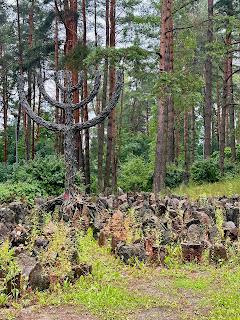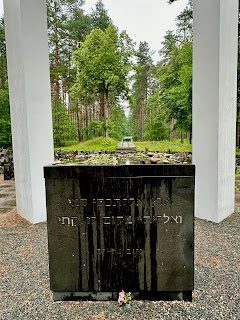We spent most of the day exploring Jewish Riga with a local tour guide, Janis Riekstins. The first thing that surprised me was the resurgence of a Jewish population here, unlike Poland. Out of every 1,000 Latvians, 2.26 are Jewish. About 4,300 Jews call Latvia their home with 8,000 Jews having Jewish parents.
Our first stop on the tour was a visit to an active synagogue, Peitav-Shul. It was built in 1905 in the art nouveau style of architecture with Egyptian and Assyrian motifs. Although the Nazis destroyed most of the synagogues in Latvia, the building is in the middle of Old Town Riga, making it too dangerous to burn down without destroying other buildings. Instead, the Germans removed the bimah and covered the ark with a wooden wall, burying the torahs and other religious books and artifacts behind it and used the building as a warehouse.
When the wooden wall was removed after the war, the torahs were saved and brought back into use. During the Soviet occupation it was one of the only synagogues that was allowed to remain active. The current restoration of the synagogue was completed in 2005. The stained-glass windows are original to the building, and the paint reflects the original style, reflecting the Egyptian influence.
The art nouveau exterior of the synagogue
Original stained-glass windows
Interior of the Peitav-Shul
The Museum of the Riga Ghetto and Holcaust in Latvia revealed a history of Riga during World War II that was in some ways very much like the rest of Europe, but also with some surprises. The Germans took over most of the factories, but they needed cheap labor so they sent Jews from Lithuania, Austria, Germany, and Poland (including Auschwitz) to work. Similarly to the Plaszow Camp depicted in Schindler's List, the workers were confined to the Riga Ghetto. At one point over 30,000 Jews were living in the ghetto.
A train car used to transport Jewish prisoners to work in the Riga factories
The story of Riga Jews originally confined to the ghetto
One room of the museum housed sketches by Aleksandra Belcova,
a Russian-Latvian artist who witnessed the horrors of the Holocaust
A mural outside the Riga Ghetto Museum
Rather than transported to concentration camps, most of the Jews living in the Riga Ghetto were exterminated in two local forests. The Nazis dug trenches before marching the Jews to the forests where they were each shot with one bullet. The luckier ones died instantly, falling into the trench while others survived only to die later. There were some survivors, including a little boy who hid under the pile of clothes from the victims who were made to undress first. After the Nazis left, he ran to the local Catholic Church where the priests saved him by dressing him as a little Latvian boy and insisting that he was Christian. Rumbula Forest, closest to the ghetto, was the scene of the extermination of over 25,000 Jews. Although the Germans dug up the mass graves and incinerated the bodies, the Russians made sketches of the locations of the graves that were later used to build the memorial.
Memorial Stone at the entrance to Rumbula Forest
Path leading to the mass graves
Memorial on site of one of the mass graves
Menorah surrounded by stones marking the people and cities of those murdered here,
forming the shape of the Star of David
A close-up of the stones and city -- in this case Stuttgart -- from which the victims originated.
Memorial with an ecumenical prayer, dedicated in January 2022
Most of our tour today was done in rain, which you can see from the rain-soaked memorials in the killing fields. When we passed what I thought was the remains of the Great Choral Synagogue, we stopped the car and viewed the scene from the window. In fact, the structure we were seeing was not the remains of the synagogue, but a memorial to its destruction. Destroyed by the Nazis, the building was burned to the ground. The little ruins that remained were buried underground. The memorial was built on the footprint of the original synagogue.
Memorial to the Great Choral Synagogue
Although at least one other synagogue building survived the Nazis, the Soviets only allowed the one to exist as a place of worship. This synagogue, one of the extant exterior structures, was turned into an apartment building, now in one of the poorer sections of the city. A Star of David originally surrounded six-sided window on the top of the synagogue which you can still see on the top here.
Between the destruction by the Nazis and the Soviets, none of the Jewish cemeteries remain. Some contain broken headstones, but the Riga Old Jewish Cemetery is totally gone. Today it stands as a memorial park.
Memorial headstone at the Old Jewish Cemetery
"This is Riga's first Jewish cemetery. It was opened in 1725 and burials continued here until the
late 1930s. After German forces occupied Riga in 1941, the prayer house and the mortuary were burned down. The cemetery became a mass burial site for over 1,000 Jews killed in the streets
and houses of the Riga Ghetto. Following World War II, many of the cemetery's tombstones were removed and used as building material. Others deteriorated. The wall surrounding the cemetery collapsed, and the site left uncared for fell into despair. In the 1960s the site was razed and renamed "The Park of the Communist Brigades." In 1992 the park was renamed "The Old Jewish Cemetery."
Zania and Johanna Lipkes were "Righteous Gentiles" Latvians who saved over 60 people from the Nazis by hiding them in a bunker under a storehouse on their farm. The Zania Lipkes Memorials is a museum dedicated to the couple, the others who helped them, and those who survived. The Lipkes lived close to the port on the Daugav River. It was Johanna who first considered hiding Jews at their home. Zania, who was at first hesitant, decided to help when he learned of the death of family friends in the Ghetto. As a smuggler who was also assigned to transfer people to and from the ghetto, giving him access to help people escape to his bunker. Zania and Johanna Lipkes have a memorial tree as part of the "Righteous Among the Nations." Watched by the Soviets, Zania had to smuggle himself out of Latvia in order to travel to Israel to accept his honor.
A brief clip from a video of Johanna Lipkes giving testimony
about she and her husband hiding Jews from the ghetto.
The video runs at the bottom of the bunker so it is taken from above.
You will hear our guide talking about the daring rescues.
Although our exploration of Jewish Riga focused on the Holocaust and post-World War II, it was interesting to learn about the history of the Litvaks (Yiddish word for Latvian Jews) after my great grandmother left the area. Of course, at that time (she left in 1903), Dvinsk was a part of the Russian Empire. The first wave of Jewish emigration was during the pogroms. World War II was devastating to the Jews, and life under Soviet rule was harsh. But after Latvia became an independent republic in 1991, the population of Jews in Latvia began to grow, although in much smaller numbers than at the turn of the 20th century.





















No comments:
Post a Comment